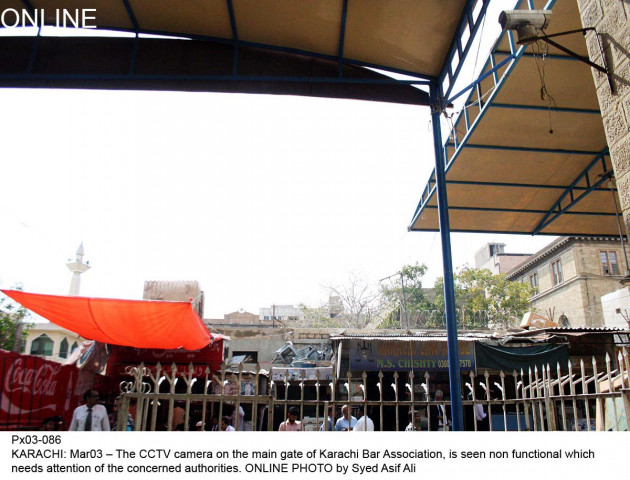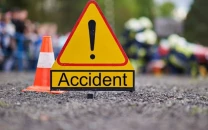Judicial lockdown: More security for judicial officers, less access to litigants
Justice Baqar directed govt to install more CCTV cameras as well as increase deployment of law enforcers at high court

The non-functional CCTV camera at the main gate of the Karachi Bar Association. PHOTO: ONLINE
Saleem Akhtar’s lean frame is a mismatch with the heavy machine gun hanging from his shoulder. But his heart and spirits are in the right place. “Anyone coming with their nefarious intentions won’t be spared,” said the determined police commando.
Clad in an all-black uniform, he stands guard outside the courtroom of a judge at the Sindh High Court. Akhtar was referring to the possibility of an attack by militant outfits involved in acts of terrorism and sectarian violence that keep hurling threats to blow up the court’s building or harm the judges.
“They will die, not us,” the middle-aged man added while thumping his chest under the heavy metal bullet-proof vest with one hand and clutching the butt of his gun with the other.
Dozens of policemen, who have undergone special anti-terrorism training, along with Rangers personnel have been guarding the high court since 2012. The security was increased when a sectarian outfit started making hoax calls, warning to target some of the judges that they believed had favoured people from a particular sect in their judgments in criminal cases.
“The commandoes have been deployed at the court ever since and security keeps being tightened with time,” a court security officer told The Express Tribune.
While these stringent security measures have been effective in preventing untoward incidents from taking place within the courts premises, the legal fraternity is still a target outside as seen in June 2013 when senior judge, who is now the SHC chief justice, Justice Maqbool Baqar, was attacked. A dozen people, including eight security personnel, were killed. This led to an overhaul of the security plan. Now, a portion on the building’s second floor, which comprises the courtrooms and chambers of the chief justice and the senior puisne judges, has been cordoned off.
Other precautionary steps, such as installation of electronic metal and explosive detectors along with visitors’ pat-downs, can be seen at the courts. The parking areas for the four-wheelers and two-wheelers have been separated with the reasoning that motorcycles are commonly used to carry out explosions in the country. And this parking facility is strictly limited to judges, lawyers, court’s staff and litigants only.
Separate entrances
The high court’s historic building was designed to have four entrances for public’s convenience. According to officials, now only one entrance is allowed to be used by lawyer, staff and litigants on the Sir Ghulam Hussain Hidayatulah Road. The main entrance on Shahra-e-Kamal Atta Turk is used by judges, while the remaining two gates opening towards the old Sindh Secretariat’s barracks have been closed.
The visitors, especially litigants, however, feel that these measures have restricted their movement. “A recent order directed that the gate opening in the barracks should not be used by the public as the security of the Anti-Terrorism Courts could be compromised,” explained a security personnel, adding that the other gate towards the information department was also rarely used and only opened for the public on Fridays to facilitate those going to offer prayers in the nearby mosque in the barracks.
Not safe enough
The murder of the son of a district and sessions judge in Hyderabad on February and the killing of a judge in an attack in Islamabad on Monday has once again raised concerns about the security of judicial officers. While chairing a high-level security meeting with officials of Sindh government, police and Rangers on Monday, Justice Baqar directed the government to install more CCTV cameras as well as increase deployment of law enforcers at the high court and subordinate courts. These directives could possibly lead to more stringent safety for judicial officers and even less access for litigants.
Published in The Express Tribune, March 4th, 2014.



















COMMENTS
Comments are moderated and generally will be posted if they are on-topic and not abusive.
For more information, please see our Comments FAQ